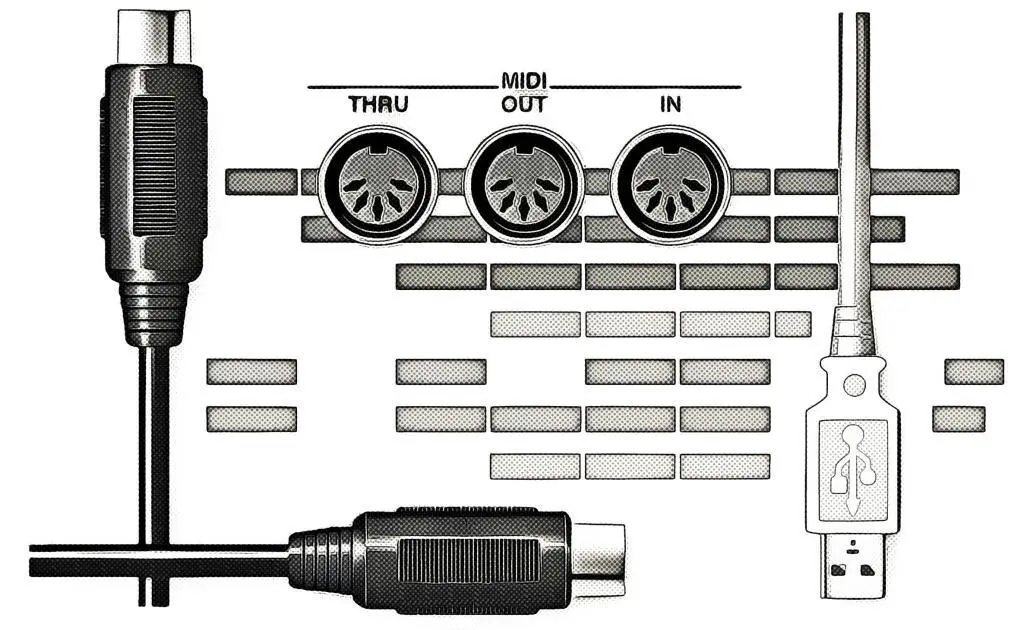MIDI, the abbreviation for Musical Instrument Digital Interface represents the industry communications protocol that enables electronic musical instruments, computers, controllers, mixing desks and a lot of other related devices to connect with one another and communicate. This is also the main purpose. Digital instruments and devices can interpret MIDI commands. A single MIDI file can communicate up to sixteen channels of information.

What is MIDI: Table of Contents
Introduction to MIDI
MIDI is a crucial component of modern music production and performance. It’s a communication protocol that enables electronic musical instruments, computers, controllers, mixing desks, and other related devices to connect with one another and communicate. This article will explore what MIDI is, its history, how it works, its different formats, and advanced techniques.
MIDI is short for Musical Instrument Digital Interface. It’s a protocol that enables electronic musical instruments and devices to communicate with each other. The MIDI protocol was first introduced in 1983 by Dave Smith and Chet Wood, who were then working for Sequential Circuits. MIDI is not an audio signal, but rather a digital signal that transmits performance data. MIDI data includes note on/off, pitch bend, modulation, and other performance parameters. Unlike audio signals, MIDI data can be edited, manipulated, and played back at different times.
MIDI messages can be sent and received by any MIDI-enabled device, such as electronic keyboards, synthesizers, drum machines, sequencers, and even software programs. MIDI data can be transmitted through various means, including MIDI cables, USB cables, or wirelessly via Bluetooth.
Benefits of Using MIDI
Using MIDI has several benefits in music production. First, it enables musicians and producers to work with a wide variety of electronic instruments and devices, regardless of the manufacturer. Second, it allows for precise control of performance parameters, such as note velocity, duration, and pitch bend. Third, it enables producers to edit and manipulate performance data after it has been recorded, making it easier to correct mistakes, experiment with different sounds, and create complex musical arrangements.
The History of MIDI
Before MIDI, electronic musical instruments were limited in their ability to communicate with each other. Different manufacturers used different communication protocols, which made it challenging to integrate different devices into a single system. In the early 1980s, Dave Smith and Chet Wood recognized this problem and proposed a standard communication protocol that could be used by all electronic instruments and devices.
The first MIDI standard was introduced in 1983, and it quickly became widely adopted by the music industry. MIDI enabled musicians and producers to connect different electronic instruments and devices, regardless of their manufacturer, and control them using a single interface. This made it possible to create complex musical arrangements and integrate different types of electronic instruments into a single performance.
How MIDI Works
MIDI data is transmitted using digital messages. These messages are sent and received by MIDI-enabled devices and are used to control various performance parameters, such as note on/off, pitch bend, and modulation. MIDI data is transmitted at a rate of 31,250 bits per second, which is much slower than audio data. However, because MIDI data is much smaller in size than audio data, it can be transmitted without any noticeable latency.
MIDI messages are transmitted using MIDI channels. A single MIDI file can communicate up to sixteen channels of information. Each channel can transmit different performance parameters, such as note on/off, velocity, and pitch bend. This enables musicians and producers to control multiple instruments or tracks simultaneously.
Different Types of MIDI Messages
There are three main types of MIDI messages: channel messages, system messages, and real-time messages.
- Channel messages are used to control individual channels and include note on/off, velocity, and pitch bend. These messages are transmitted over a specific channel and can be used to control different parameters of a single instrument or track.
- System messages are used to control system-wide settings and include tempo, time signature, and song position. These messages are sent to all devices in the system and are used to control the overall performance.
- Real-time messages are used to control performance parameters in real-time and include start/stop, continue, and timing clock. These messages are sent during performance and can be used to synchronize different devices and tracks.
- Real-time messages are used to control performance parameters in real-time and include start/stop, continue, and timing clock. These messages are sent during performance and can be used to synchronize different devices and tracks.
MIDI Formats
There are two main types of MIDI formats: Type 0 and Type 1.
- Type 0 format contains all MIDI data in a single track, which can be useful for small projects or performances. However, this format doesn’t allow for independent control of different channels or tracks.
- Type 1 format contains multiple tracks, each containing different MIDI data, which can be used to control different channels or instruments independently. This format is more flexible and suitable for larger projects or performances.
Advanced MIDI Techniques
MIDI can be used in several advanced techniques that enable musicians and producers to create complex musical arrangements and performances. Some of these techniques include:
- MIDI Mapping: This technique involves mapping different MIDI parameters to different hardware or software controls, such as knobs or faders. This enables musicians and producers to control different parameters of a single instrument or track using different hardware or software controls.
- MIDI Sequencing: This technique involves using a sequencer to record, edit, and manipulate MIDI data. A sequencer can be used to create complex musical arrangements by layering different tracks or channels and adjusting their timing and pitch.
- MIDI Programming: This technique involves manually entering MIDI data into a software program, such as a digital audio workstation (DAW). This enables musicians and producers to create complex musical arrangements by manually adjusting different performance parameters, such as note duration, velocity, and pitch bend.

